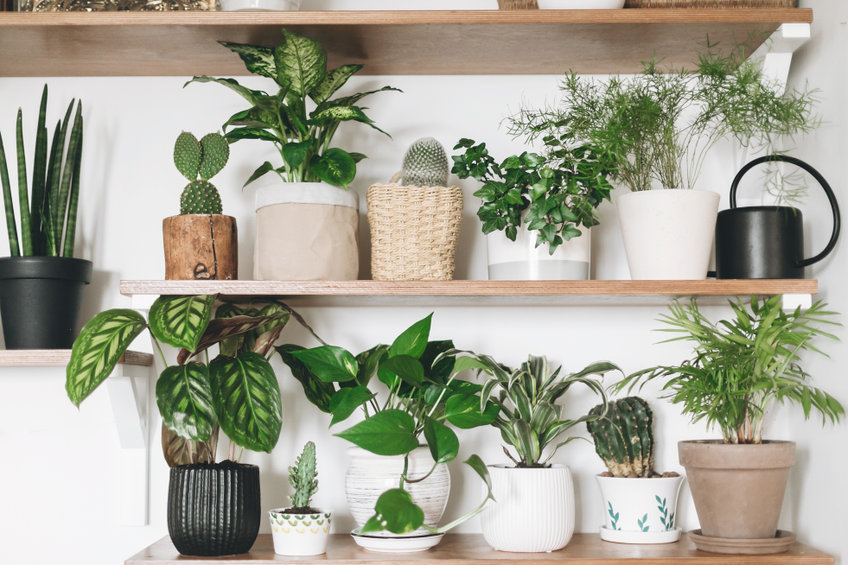Selecting Houseplants for Indoor Use

Not only can indoor plants bring a natural element to your living area, but they also enhance the air quality and create a calm atmosphere. Choosing the ideal indoor plants for your home can be an exciting and difficult task, especially with so many options available. We'll walk you through the process of selecting indoor plants in this post that complement your aesthetic preferences, way of life, and level of care.
- First Off
- Advantages of Indoor Plant Life
- Evaluating Your Area
- Taking the Lighting into Account
- Plants Tolerant of Low Light
- Lover of Direct Sunlight Plants
- Selecting According to Maintenance
- Options for Pet-Friendly Plants
- Plants that Clean the Air
- Aesthetic Points to Remember
- Size and Positioning
- Containers and Plant Pots
- Watering and Upkeep Advice
- Taking Care of Typical Problems
- In summary
- Q&As
First Off
Any living area can be transformed into a colorful haven with the help of indoor plants. Their calming presence and abundant foliage can significantly improve the atmosphere in your house.
Advantages of Indoor Plant Life
There's more to indoor plants than just aesthetics. By releasing oxygen and absorbing carbon dioxide, they also enhance the quality of the air. According to studies, having indoor plants can improve mood, lower stress levels, and increase productivity.
Evaluating Your Area
Consider the size of your living area before choosing plants. Take into account the floor area that is available, windowsills, and plant-friendly shelves.
Taking the Lighting into Account
Different plants require different amounts of light. Choosing the right plants for your home requires an understanding of the lighting conditions there.
Plants Tolerant of Low Light
Choose plants like peace lilies, snake plants, or ZZ plants if your home receives little natural light. These plants do well in conditions with little light.
Lover of Direct Sunlight Plants
Think about adding cacti, succulents, or a Fiddle Leaf Fig to areas that receive lots of sunlight. Make sure they are positioned close to windows so they can get plenty of sunlight.
Selecting According to Maintenance
Think on your dedication to maintaining plants. More care is needed for some plants than for others. Start with low-maintenance plants like Pothos or Spider Plant if you're just starting out.
Options for Pet-Friendly Plants
Make sure the plants you select won't harm your pets if you have any. Areca palms, Boston ferns, and spider plants are good options.
Plants that Clean the Air
Better air quality can be achieved with indoor plants. Plants with air-purifying qualities include peace lilies, aloe vera, and snake plants.
Aesthetic Points to Remember
Choose plants that complement the design of your house. There is a plant for every aesthetic, whether you like bohemian vibes or modern minimalism.
Size and Positioning
Think about the plants you select based on their mature size. Certain plants may outgrow their containers, creating claustrophobic living circumstances.
Containers and Plant Pots
Selecting the appropriate pots and containers is crucial. In order to avoid overwatering, make sure they have drainage holes.
Watering and Upkeep Advice
Overwatering is a frequent problem. Make a schedule for watering your plants based on your research into their individual requirements.
Taking Care of Typical Problems
Indoor plants are susceptible to fungal diseases, pests, and yellowing leaves. Learn to recognize these issues and take quick action to fix them.
In summary
Adding indoor plants to your house can improve both the aesthetics and your health. You can create a peaceful indoor green haven by taking your space, lighting, maintenance capabilities, and aesthetic preferences into account.
Q&As
Is it okay to have indoor plants in my restroom? Yes, a lot of plants, including orchids and Boston ferns, do well in the humid conditions of a bathroom.
How frequently should my houseplants be fertilized? During the growing season, fertilize your plants every four to six weeks (spring and summer).
What should I do if the edges of the leaves on my plant are becoming brown? Low humidity may be indicated by browning leaf edges. Regularly mist the plant or use a humidifier.
Are insects drawn to indoor plants? Although certain plants may draw insects, infestations are typically avoided with good upkeep and care.
Where can I purchase houseplants? Local nurseries, garden centers, and even online plant stores carry indoor plants.

Deja una respuesta